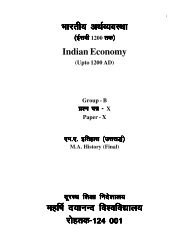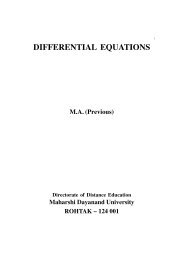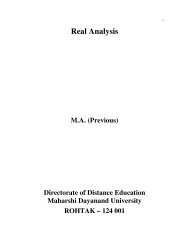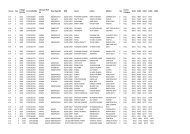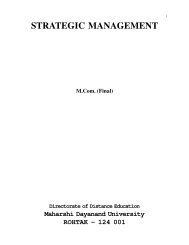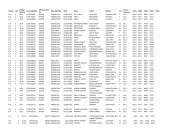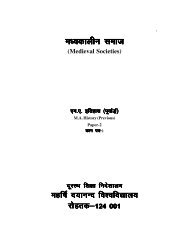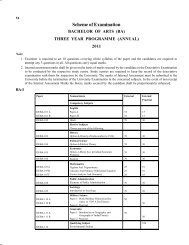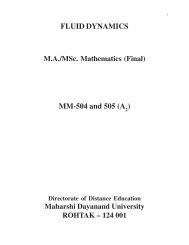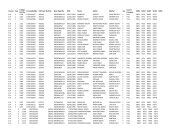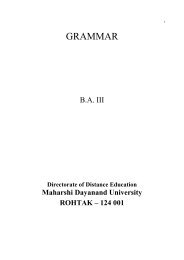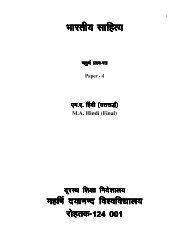Advanced Abstract Algebra - Maharshi Dayanand University, Rohtak
Advanced Abstract Algebra - Maharshi Dayanand University, Rohtak
Advanced Abstract Algebra - Maharshi Dayanand University, Rohtak
You also want an ePaper? Increase the reach of your titles
YUMPU automatically turns print PDFs into web optimized ePapers that Google loves.
UNIT-IV 87<br />
M ⊂ M′ ⊂ R M′ = R or M′ = M.<br />
Example. An ideal generated by a prime number is a maximal ideal of the ring of integers. But<br />
the zero ideal of the ring of integers is not maximal.<br />
Proof. Let p be any prime integer and let S be any ideal containing the principal ideal generated by p.<br />
Now the ring of integers being principal ideal ring the ideal S is a principal ideal and it is generated by<br />
the integer q. We have therefore<br />
(p) ⊂ (q) ⊂ R<br />
p ∈ (q)<br />
p = kq, k ∈ R .<br />
Since p is prime, p = kq either k = 1 or q= 1 .<br />
Now k = 1<br />
p = q<br />
(p) = (q)<br />
and q = 1 (q) = (1) = R (Since R is generated by 1) .<br />
Hence (p) is maximal ideal.<br />
Theorem. Every maximal ideal M of a commutative ring R with unity is a prime ideal.<br />
Proof. It suffices to prove that if a, b ∈ R then<br />
ab ∈ M a ∈ M or b ∈ M .<br />
Let us suppose that a ∉ M. If we prove that b ∈ M then we are done. It can be seen that the set<br />
N = {ra + m | r ∈ R, m ∈ M}<br />
is an ideal of R.<br />
Since 1 ∈ R, therefore a + m ∈ N. But a+m ∉ M since a ∉ M. Therefore<br />
M ⊂ N ⊂ R , M ≠ N.<br />
M being a maximal ideal asserts that N = R. Therefore 1 ∈ R 1 ∈ N. So we can find two elements r<br />
∈ R, m ∈ M such that<br />
1 = ra + m<br />
b = r(ab) + mb, b ∈ R<br />
Since M is an ideal of R, therefore<br />
ab ∈ M, r ∈ R r(ab) ∈ M<br />
and m ∈ M , b ∈ R mb ∈ M .<br />
Therefore b ∈ M.<br />
Hence M is a prime ideal.<br />
Theorem. An ideal M of a commutative ring R with unity is maximal if and only if R/M is a field.<br />
Proof. Let M be a maximal ideal of R. Since R is a commutative ring with unity, R/M is also a<br />
commutative ring with unity element. Let A* be an ideal of R/M and<br />
A = {r | r+M ∈ A*}<br />
If r , s ∈ A , then r+M, s+M ∈ A*. Therefore<br />
<br />
(r−s) + M = (r+M) − (s+M) ∈ A*<br />
r−s ∈ A<br />
If r ∈ A, t ∈ R, then<br />
r+M ∈ A* and



